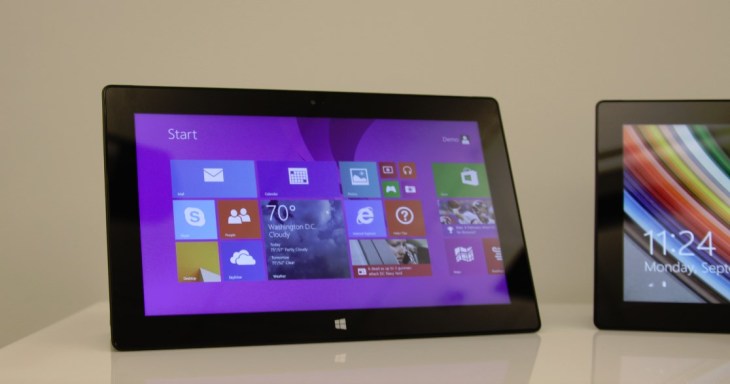Today Microsoft took the wraps off its holiday hardware lineup, unveiling two new tablets, and a number of new and updated accessories. It’s a lot of information to process, so let’s go through each piece in order.
I spent time in Redmond last week with the new hardware, and the team behind the Surface project itself. Hands on notes regarding the Surface 2 and Surface Pro 2 will be published following this piece, along with an extensive interview with Brian Hall, current general manager of the Surface effort, and Panos Panay, corporate vice president at Microsoft and chief of Surface.
For now, you need an overview of what’s new. We’ll get granular shortly. Here’s the once-over.
Surface 2
The Surface 2 is the second generation of the Surface RT, though its name doesn’t take after its ancestor. In its most basic formulation, the Surface 2 is quite similar to its predecessor: It is an ARM-based tablet that supports attachable keyboards, and is built to make Windows 8(.1) sing.
That aside, Microsoft has made across-the-board improvements to the product itself. Battery life has been bettered by 25%. A new processor (the NVIDIA Tegra 4 chip) has improved speed and graphical performance. The kickstand now includes a second, deeper angle that makes using the device on your lap far simpler. It has a new look, with a silver magnesium case that resists fingerprints, and is sturdier. It has improved cameras to better support low light settings, helping you Skype with folks in darker rooms. And, it’s cheaper, starting off at $449 – Surface RT headed into the market for $499.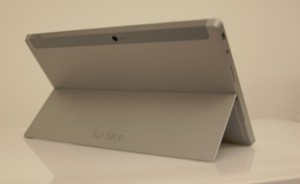
If you think that Windows 8.1 matures the Windows 8 platform sufficiently for daily use, and that the Windows Store has become populated enough with applications in its year of life, the Surface 2 could be a device that you enjoy. Certainly, the hardware has has improved greatly since its first generation. The question becomes how well Windows 8.1 can take advantage of those upgrades.
Frankly, the Surface 2 is a very good-looking device, and one that I would feel great using at a cafe if I ever worked in such desultory locales.
In that vein, its success is quite tied to that of Windows 8.1: The better Windows 8.1, the more the Surface 2’s upgrades can shine through. The Surface 2 (again, in my very limited hands-on time) proved a capable device. I can see students loving it, for example.
Surface Pro 2
If the upgrades to the Surface 2 were broad and various, the changes to the Surface Pro 2 are targeted and vertical: It’s all about battery life, baby. According to Microsoft – and more on this later – it received constant feedback that business customers were interested in the Surface Pro, but could not bear its underperforming battery life. The company is frank that its first generation Pro lacked in that department.
So, instead of changing the device externally a single mote, Microsoft rejiggered the guts of the unit into what it calls the Surface Pro 2, which will have around 60% better battery life, a figure that it claims can skew higher in certain use cases.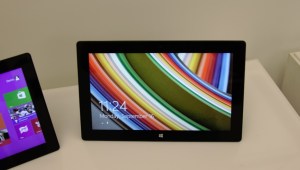
The Surface Pro 2 has been bumped up to the Haswell generation of Intel chips, can contain up to 8 gigabytes of low-power DDR RAM, and a SSD that can reach the half-terabyte mark. It also receives the new kickstand position, which Microsoft is proud of, mostly because it works.
The Surface Pro 2 looks like its predecessor, is the same size and weight, but lasts longer, and goes harder and faster if you kit it properly. It starts at the same price point as its forefather: $899.
Free Digital Goodies
Microsoft is stapling two things to each new Surface that you buy: 200 gigabytes of SkyDrive storage for two years, and a year of Skype service that includes international calling. The play here is simple: Buy a Microsoft device, and the company’s services come along with it. Microsoft, as you certainly recall, is pursuing a “devices and services” model – this is the fusion of the two.
If you were to buy 100 gigabytes of SkyDrive storage for a year, it would set you back $50. You currently can’t buy 200 gigabytes at a time. So, the SkyDrive perk is worth $200 – theoretically – by itself. Microsoft is essentially buying your digital storage custom with the deal.
The loser? Other storage companies that do not match that scale, such as Box.
New Touch Cover
The old Touch Cover was a neat piece of hardware that I, and perhaps you as well, never really mastered. It was never quite where it needed to be for me to fully trust it. Microsoft, in the past year, has built a new Touch Cover that contains 14 times as many sensors, along with firmware upgrades.
In practice, better software and a boatload of new on-keyboard sensing technology make the new Touch Cover a far superior typing experience. Would I replace my mechanical keyboard with the new Touch Cover? No, but it would make typing on an airplane a far simpler if I lived with a Surface device.
The new Touch Cover is thinner and lighter than its predecessor, and is backlit.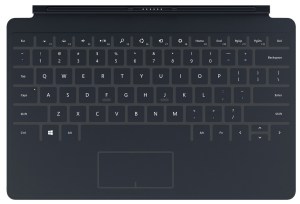
Most interesting in the new Touch Cover are gestures: Slide two fingers across the number key line, and the Touch Cover will highlight text. Release, and the selected text will be deleted. A spacebar gesture talks to Windows 8.1’s word recommendation system. There are others input methods which are worth learning. I had some trouble finding my sea legs in quick testing, but would have been able to master the set in a day, I think.
The original Touch Cover was perhaps the most innovative part of the Surface lineup. Microsoft has taken its initial product, and greatly improved it.
What’s the downside? A high price point of $119 per new Touch Cover. That’s equivalent to the price of the original Touch Cover, released last year.
Keeping The Old
The above are the most important parts of the new hardware announced today, so this is the proper moment to take an interlude and discuss what Microsoft is keeping from last year’s line of devices. The Surface RT, for $349, and the original Touch Cover, for $79, will remain on sale for the foreseeable future.
Microsoft likely has quite a number of extra units of both that it would love to get rid off, and having the cheaper set of hardware in the market allows it to, in a way, combat both the iPad Mini and Chromebooks, devices that are absorbing chunks of the lower-end PC market.
However, keep in mind that the key marketing point of the Surface line is that it is a tablet that let’s you get shit done, roughly. But you can’t really do much in terms of productivity with a Surface without a keyboard, and that means that the lowest Windows 8.1 tablet-to-get-stuff-done point remains north of $400 when you factor in its keyboard accessory. Microsoft could release a bundle of Surface RT and Touch Cover for $400, but the company told me that it has moved away from bundling its hardware, so don’t expect it.
Here’s the funny part: Microsoft Office 2013 Professional, for a single user on a single PC, currently costs $400 on Amazon. That’s nearly as much as a Surface RT and Touch Cover that come with the basic Office suite. We’re seeing hardware price declines clip the top end of software costs. It’s a market trend to keep in mind.
Power Cover
Microsoft has produced a new, third keyboard variety for its Surface tablets: The Power Cover. It’s thicker version of the Type Cover, essentially, that can greatly add to the amount of juice your tablet can drink from.
I was told that a Surface Pro 2 with a fully charged Power Cover can last roughly 2.5 times as long as a Surface Pro with a Type Cover. Snap a Power Cover on your current Surface Pro, and you’ll get around 60% more battery life.
So, if you have a long flight ahead, this Cover could be the one for you. I don’t have pricing details at this point, but expect the Power Cover to cost between $150 to $200.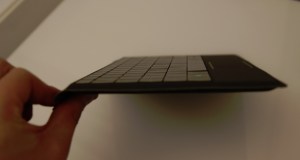
One neat trick about the Power Cover is that so long as it has energy, it will dump it into the Surface. So, if you have a 90% charged Surface Pro 2 attached to a Power Cover with any battery at all, it will upload that power into the tablet itself, even while stashed in a briefcase. Not a cheap solution, but an option for those who need it and aren’t price sensitive.
New Type Cover
Along with the new Touch and Power Covers, Microsoft has remade its Type Covers to include quieter keys, backlighting, and different colors. So, if you want to have a keyboard that includes moving keys for your Surface, you can get it in magenta, or blue. Whatever strikes your fancy.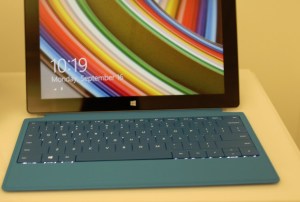
Previously, while Touch Covers came in a number of colors, the Type Cover was stuck in a Fordian black, befitting its more business focus. Well, it would appear that folks wanted their typing to be a bit more stylish.
Dock
The dock. This leaked ages past, but it’s worth discussing here briefly. The Surface dock is a move by Microsoft to better integrate its Surface Pro 2 device into the workplace.
It has USB 3.0 and 2.0 ports, an ethernet jack, a Mini Display port, and two audio jacks. If you use all four USB ports, Microsoft confirmed to TechCrunch that the dock can support them all at full power.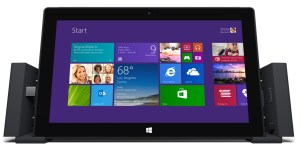
The dock works in the following way: You place your Surface Pro 2 device (keyboard can stay attacked) in between the twin arms of the dock, which you then press into the unit, with one port on either side of the device used to hold it in place.
From there, you have wired Internet, peripherals as you need, and, of course, simple multi-monitor support. You can also yank the Touch Cover and use a larger keyboard if you want.
Other Bits And Pieces
What else is out today? A wireless adapter for Touch and Type Covers that turns them wireless, so you can type back from your screens. I’m not sure how popular the doodad will be, but if you can use a Touch Cover on a non-Surface device, that could boost the popularity of the pair.
Finally, Microsoft has created a mouse-variant called the Touch Mouse Surface Edition. It’s designed to work with the Surface devices. I honestly don’t have much on it, but if I get my hands on one, will review it for you.
—
That is the rough lay of the land. TechCrunch has more breaking news and analysis on the way, so strap in.
Top Image Credit:
